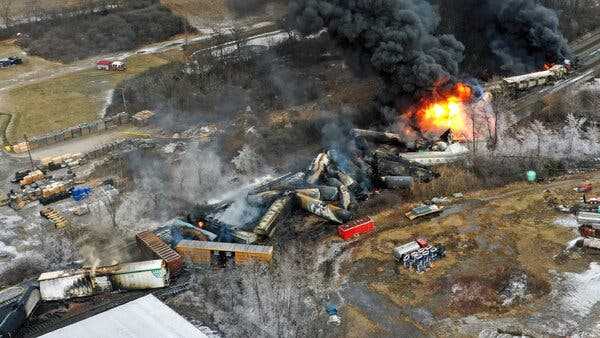In advance of a two-day hearing on the derailment of a Norfolk Southern freight train in Ohio, investigators released a trove of documents about the accident.
- Give this article
- +

Thirty-eight cars left the tracks when a Norfolk Southern freight train derailed in East Palestine, Ohio, in February, and 11 of them contained hazardous materials, according to investigators.
The National Transportation Safety Board released thousands of pages of documents on Thursday about the derailment of a Norfolk Southern freight train in East Palestine, Ohio, providing the fullest account yet of what led to the accident.
The agency released the trove of documents ahead of a two-day hearing in East Palestine, which began on Thursday morning and is set to examine several aspects of the derailment and the emergency response that followed, including the decision to conduct a controlled burn of some toxic chemicals the train was carrying.
The N.T.S.B. held a community meeting on Wednesday night to field questions from residents, and the agency’s chairwoman, Jennifer Homendy, opened the hearing on Thursday morning with a message for those affected by the derailment.
“Just know that all of us think about you, not just during this hearing, not just during the investigation, but well after our final board report is issued,” she said.
The N.T.S.B. had previously said that a wheel bearing on one of the rail cars had overheated as the 149-car train passed through Ohio on Feb. 3. The documents released on Thursday offered a more detailed picture of what happened in the moments before the train left the tracks and how officials responded to the derailment and the fire that ensued.
According to the documents, a part of the rail car’s wheel set came off, leading to the derailment. The wheel bearing that overheated was found just over 100 feet away from the point of derailment lying in a small, wooded area, and that it had “extensive thermal damage.”
Ultimately, 38 cars ended up derailing, including 11 that contained hazardous materials, according to the safety board.
In the aftermath of the accident and the controlled burn, officials said they had not detected dangerous levels of chemicals in the air or the municipal water system. But some people experienced symptoms like rashes and headaches, leaving residents to worry about potential long-term health risks stemming from the release of toxic chemicals.
The Justice Department sued Norfolk Southern in March over the derailment, and the N.T.S.B. opened a special investigation into safety practices at the company. The derailment has also prompted a bipartisan effort in Congress to pass new rail safety legislation. At a Senate hearing in March, Norfolk Southern’s chief executive, Alan H. Shaw, told lawmakers that he was “deeply sorry” for the effects of the derailment.
Daniel McGraw contributed reporting from East Palestine, Ohio.
Mark Walker is an investigative reporter in the Washington bureau. He was part of a team that won a Pulitzer Prize for its coverage of Covid-19 in 2020. He grew up in Savannah, Ga., and graduated from Fort Valley State University. @bymarkwalker
Peter Eavis is a New York-based reporter covering companies and markets. Before coming to The Times in 2012, he worked at The Wall Street Journal. @PeterJEavis
+
- Give this article
- +
Source: nytimes.com



